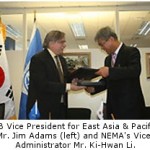
Bonn – According to UNFCCC Executive Secretary Christiana Figueres, governments meeting at the UN Climate Change Conference in Bonn (2 to 6 August) have made progress towards deciding the shape of a successful result at the November/December UN Climate Change Conference in Mexico, but now need to narrow down the many options for action on climate change presently under negotiation.
In Bonn, many governments said they believed a set of COP decisions which quickly operationalize key elements of the Bali Action Plan would be an achievable outcome of Cancún.
“This means countries could agree to take accountable action to, for example, manage and deploy climate finance, boost technology transfer, build skills and capacity to do this and deal with adaptation, especially in the poorest and most vulnerable countries,” said UNFCCC Executive Secretary Christiana Figueres.
The Bali Action Plan, agreed in 2007, serves as a basis for work under the Ad Hoc Working Group on Long-term Cooperative Action under the Convention (AWG-LCA). The negotiating group is tasked to deliver a long-term global solution to the climate challenge.
“Progress at Cancún would also include a mandate to take the process inexorably forward towards an encompassing agreement with legally binding status, which would take more time,” Ms. Figueres said.
The Ad Hoc Working Group on Further Commitments for Annex I Parties under the Kyoto Protocol (AWG-KP) also met in Bonn in parallel to the AWG-LCA. The focus of this group is on emissions reduction commitments for the 37 industrialized countries that have ratified the Kyoto Protocol for the period beyond 2012.
The chair of the Kyoto Protocol negotiating track, John Ashe, produced a draft proposal text which governments will be able to consider between now and the next UNFCCC negotiating session in October.
That text includes a possible set of draft decisions for Cancún, including impacts of agriculture on emissions, carbon markets and mechanisms, greenhouse gases, and the effects on different countries of moving to a low-emissions future.
The UNFCCC Executive Secretary warned that many countries had reinserted established positions into the texts, increasing the number of options for action. “To achieve desired outcomes in Cancún, governments must radically narrow down the choices on the table,” she said.
Ms. Figueres called on governments to agree further compromises at all levels between now and the UN Climate Change Conference 29 November to 10 December in Cancún. Significant opportunities for this are the high-level meetings which are scheduled in Geneva and New York in September, followed by the next UNFCCC negotiating session in Tianjin, China (4 to 9 October).
“This week has given governments a final opportunity to be clear on their individual stances. Tianjin has to be the place where they make clear what their collective stance is going to be,” she said.
The Bonn UN Climate Change Conference was attended by 1656 participants from 175 countries.

About the UNFCCC
With 194 Parties, the United Nations Framework Convention on Climate Change (UNFCCC) has near universal membership and is the parent treaty of the 1997 Kyoto Protocol. The Kyoto Protocol has been ratified by 190 of the UNFCCC Parties. Under the Protocol, 37 States, consisting of highly industrialized countries and countries undergoing the process of transition to a market economy, have legally binding emission limitation and reduction commitments. The ultimate objective of both treaties is to stabilize greenhouse gas concentrations in the atmosphere at a level that will prevent dangerous human interference with the climate system. For more details, visit http://unfccc.int
Source: UNFCCC Press Release dated August 6, 2010.
Related Features:












